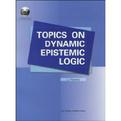动态认知逻辑专题研究
出版时间:2010-3 出版社:李小五 中山大学出版社 (2010-03出版) 作者:李小五 页数:367
Tag标签:无
前言
Dynamic Epistemic Logic is the logic of knowledge, actions and the interrelation of them.This is not about one logic, but about a whole family of logics that allows us to specify staticand dynamic aspects of rational agent systems. The book provides various logics to supportsuch formal specifications.Knowledge here is understood in a broad sense, that is, we see also doxastic logic as asort of epistemic logic.Knowledge is defined as a set of propositions that an agent knows in the classicaldynamic epistemic logic. In other words, cognitive objects of the agent are propositions forsuch logic. But, in my opinion, cognitive objects of an agent can also be actions, agents,individuals and so on.Hence, in this book, we will study such cognitive objects by logical methods.In the book, except classical logical methods, we mostly use four methods: Semi-infinitary Method, Bounded-valuation Method, Self-substitution Method and Fixed-pointMethod. By Semi-infinitary Method we mean a method presented by de Lavalette, Kooi andVerbrugge [2004], where they used such a method to prove strong completeness of PDL.But it seems to me that Bounded-valuation Method, Self-substitution Method and Fixed-pointMethod are new ones.
内容概要
Dynamic Epistemic Logic is the logic of knowledge, actions and the interrelation of them.This is not about one logic, but about a whole family of logics that allows us to specify staticand dynamic aspects of rational agent systems. The book provides various logics to supportsuch formal specifications.
书籍目录
Chapter 1 Foundations 1 Epistemic Logic 2 Dynamic Logic PDL3 Dynamic Logic PDL~0 and One Generalization of It4 Dynamic Epistemic LogicChapter 2 Do an Action1 Logics for Having Done an Action ( 1 )2 Logics for Having Done an Action ( 2 )3 Logics for Intending to Do an Action4 Logics for Being Doing an ActionAppendix 1 A Logic for Transferring a State by Resultant ForceAppendix 2 A Logic for Achieving an Intention by Doing an Action..Chapter 3 Know an Action1 Self-substitution Systems .2 Some Versions of Self-substitution Systems3 Minimal Systems and Bounded-valuation Method4 Semi-infinitary Proof Systems5 Fixed Point Systems6 Systems Containing Dot or Dga Appendix What Is an Epistemic ActionChapter 4 Cognize an Agent1 Dynamic Epistemic Logics for Knowing an Agent2 Epistemic Logics for Knowing an Agent3 An Auto-epistemic Logic for Knowing an Agent 4 A Dynamic Doxastic Logic for Believing an AgentChapter 5 Cognize a Concept1 Know a Modality Concept2 Cognize a Cognitive Concept3 Cognize a General Modal ConceptChapter 6 Know an Individual and Know a Relation1 Know an Individual2 Know a RelationAppendix A First-order Epistemic LogicChapter 7 Dynamic Negation1 Characterization by Abbreviations2 Characterization by Binary Relations3 Characterization by Ternary RelationAppendix A Action is Negated by Another ActionChapter 8 Dynamic Conditional Logies1 Conditional Logics for 2 Conditional Logics for 3 Conditional Logics for Chapter 9 Update Semantics for Epistemic Systems1 General Update Semantics2 Degenerate Frame Semantics3 Point Relation Frame Semantics4 Set Relation Frame Semantics5 Transformation Function Frame Semantics6 Selection-class Function Frame Semantics7 Neighborhood Function Frame Semantics8 Dynamic Frame SemanticsBibliography后记
章节摘录
插图:As far as we know, PDL and PDL do not characterize directly the logical properties of "anagent has done an action" from the aspect of syntax (with respect to an axiomatizationsystem). For example, they do not characterize directly the sentences of the form "He hasgone". In other words, they just characterize the sentences of the form [a] w.r.t, action ~,but such sentences just characterize t indirectly. As for the sentences of the form "He hasgone" from which we can generalize the sentences of the form "an agent has done action tx",denoted by D, the logics do not reveal what are logical properties of them. But in myopinion, such sentences are very important in the way of investigating agent having done anaction. How to use logical methods to characterize directly phrases of the form "an agent doesan action"? In Li Xiaowu [2005c], [2005b], [2005d], [2005e], [2006a], [2006b], [2007-1],[2007-2] and [2007-3], we have presented several classes of dynamic systems characterizingdirectly "an agent has done an action", "an agent intends to do an action" and "an agent isdoing an action", respectively, and then present the corresponding semantics, and thus provethat the systems are sound and complete with respect to the corresponding semantics,respectively. In this chapter, we will continue that research.
后记
此后记当用中文写,用英语写作对我来说是一件苦差事,虽然为了与国际接轨,正文不得不用英文写。我想我的英文一定很烂,恳请读者原谅。不是我想卖弄,形势所迫也。清代诗人袁枚有这样两句诗:苔花如米小,也学牡丹开。敢问袁先生:苔花何时学牡丹?为何学牡丹?在我看来,开自己的就是了!所以我想斗胆改动其中的一个字:苔花如米小,也似牡丹开。古今中外,逻辑学的成就似百花齐放,不乏有名贵的牡丹。我的成果,若还算得上成果的话,充其量如苔花。若开得还能让别人感到哪怕有一点别致,则万幸。此书稿在未出版前,一些逻辑专业的研究生看过其中的部分章节。对他们指出其中的一些笔误和错误,我在此表示衷心感谢。我特别要感谢的是中山大学逻辑与认知研究所逻辑专业博士生郭向阳,硕士生王景周、徐秋华和唐丽萍,厦门大学哲学系逻辑专业博士生刘佳秋。尤其是刘佳秋,她阅读了第一章,指出其中一些笔误。我要再次感谢她。此书稿第九章曾经在2009年第一学期作为中山大学逻辑与认知研究所研究生课程“更新语义与动态认知逻辑”的教材。参加此课程的学生有郭向阳、陈广明、钟盛阳和董惠敏,旁听的老师有文学锋。感谢参加此课程的学生和老师在课上参与讨论,提出问题和修改意见。董惠敏还帮助我校对了第九章,指出其中一些错误和英语上的不妥。我也要再次感谢她。这里还要指出的是,本书稿的撰写,特别是第9章的撰写,得到2008年度国家社科基金项目《更新语义与动态认知逻辑研究》(项目批准号:08BZX050)的资助。最后我要感谢中山大学出版社,由于她的资助,此书才得以出版。在此我特别要感谢中llJ大学出版社的李文先生,他为此书的编辑和出版付出了辛勤的劳动。
编辑推荐
《动态认知逻辑专题研究(英文版)》由中山大学出版社出版。
图书封面
图书标签Tags
无
评论、评分、阅读与下载
